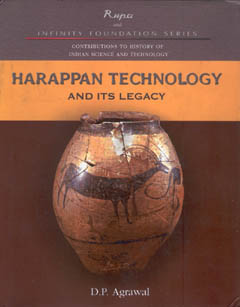Kuldip Dhiman
Harappan Technology and its Legacy
By D. P. Agrawal.
Rupa & Co. in Association with Infinity Foundation.
Pages 332. Price not mentioned.
WHAT is now known as the Indus Valley Civilisation or Harappan Civilisation was discovered accidentally when a railway line was being laid down in the 1920s. Initially, archaeological sites were found in the twin towns of Mohenjodaro and Harappa, now in Pakistan, but with the passage of time, more and more sites have been found in the north of the Indian subcontinent. It was Sir John Hubert Marshall, the then director-general of the Archaeological Survey of India who carried out initial excavations of the sites. Western historians until then had thought that India's historical past was not more than 3,000 years old, but these excavations pushed the timeline by at least 2,000 years back, if not more.
 In the present volume, Harappan Technology and its Legacy, D. P. Agrawal focuses on Harappan technological achievements, although he covers other aspects also. This is quite an exhaustive book that covers ecology, technology, architecture, arts, crafts, transportation, stone cutting art, ceramics, metallurgy, pyrotechnology, animal husbandry and agriculture. The author is an expert in the subject, and has worked with the Archaeological Survey of India, Tata Institute of Fundamental Research, and Physical Research Laboratory. He writes in a direct matter-of-fact style, and packs his thesis with hard facts.
In the present volume, Harappan Technology and its Legacy, D. P. Agrawal focuses on Harappan technological achievements, although he covers other aspects also. This is quite an exhaustive book that covers ecology, technology, architecture, arts, crafts, transportation, stone cutting art, ceramics, metallurgy, pyrotechnology, animal husbandry and agriculture. The author is an expert in the subject, and has worked with the Archaeological Survey of India, Tata Institute of Fundamental Research, and Physical Research Laboratory. He writes in a direct matter-of-fact style, and packs his thesis with hard facts.
The first thing that strikes us is the amazing care in town planning that we see in these sites. Major towns could accommodate more than 50,000 people, and the engineers and architects had to be really competent in order do design such settlements. A standard grid was followed in the design of these towns. The engineers of the time made sure to construct reservoirs for drinking water, and also made sewage lines and storm water drains. The Harappan engineering prowess is most clearly revealed in the hydraulic structures. Then we have the Great Bath, which is an example a perfect leak-proof structure.
In the past 90 years, many other sites have been discovered, and with every find, archaeologists and historians have come across amazing all round achievements of the civilisation.
Agrawal shows that when it came to scientific instruments, the Harappans contributed the true saw, needles (with holes at the pointed end), hollow drills, and so on.
"The Harappan arts and crafts," writes Agrawal, "present a bewildering array of forms, techniques, and usage of raw materials. They had a highly developed lapidary industry that could work on hard stones like agate and chalcedony, and soft stones like steatite. They could produce intricate designs by alkali etching of carnelian beads, which were probably meant for export to Mesopotamia."
Another striking feature of the civilisation was standardisation of industrial norms. The Harappans had developed a binary metrological system for measuring weights, and used a unit of 17mm for linear measurements. The bricks used in construction of buildings were of standard size—in fact, all things were standardised.
The Harappans used locally available raw materials for manufacturing crafts such as woodworking, basket making, simple weaving, terracotta pottery, and so on, although they had to import raw materials for stone-shaping for domestic purposes, and chipped stone tool-making. There was a third category crafts using local materials, complex technologies, and intricate production processes such as in stoneware bangle manufacture, elaborately painted pottery, complex weaving and carpet making, ceramics, and metallurgy. They possessed the knowledge of smelting even sulphide ores and produced bronze in complicated shapes.
The Harappans were also good at the arts and this can be seen from the surviving sculptures such as the Red Torso, the Dancing Girl, and the famous Priest King. The sculptors not only were good at human figures, but also at sculpting animals. And then, of course, we have a large collection of ceramics, pots, bowls, pans, etc.
Obviously, a civilisation that had achieved such scientific, technological and artistic heights could not have done so without having a solid agricultural base. At Kalibangan, we can still see plough marks in a field, and a terracotta model of a plough from Banawali is very elegantly designed.
One thing that sets the Harappan civilisation apart is its concern with the ordinary masses. While all the great cities of the world built great palaces and monuments which were largely for the benefit of the rich, the Harappans built structures which were for the masses like the Great Bath and the Granary. They did not show much interest in conquering; they were more interested in creating.
The book has dozens of colour photographs, maps, diagrams and sketches that beautifully illustrate the text. There is an amazing array of new artefacts that makes this volume all the more interesting.
http://www.tribuneindia.com/2009/20091213/spectrum/book2.htm
|
|
1 comment:
Great job ! It is really a treasure of information on our culture and technological advancements thousands of years ago. My best wishes to the writer and the reviewer.
Post a Comment